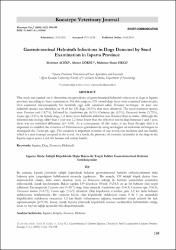| dc.contributor.author | Acıöz, Mehmet | |
| dc.contributor.author | Göksu, Ahmet | |
| dc.contributor.author | Erez, Mahmut Sinan | |
| dc.date.accessioned | 2019-02-01T07:12:39Z | |
| dc.date.available | 2019-02-01T07:12:39Z | |
| dc.date.issued | 2018 | |
| dc.identifier.citation | Acıöz M. Göksu A. Erez M.S. Gastrointestinal Helminth Infections Detected by Stool Examination in Isparta Province. Kocatepe Vet J. (2018) 11(2): 194-198. | en_US |
| dc.identifier.uri | http://dergipark.gov.tr/download/article-file/470681 | |
| dc.identifier.uri | http://hdl.handle.net/11630/5305 | |
| dc.description.abstract | Bu çalışma, Isparta yöresinde sahipli köpeklerde bulunan gastrointestinal helmint enfeksiyonlarının dışkı bakısına göre yaygınlığının belirlenmesi amacıyla yapılmıştır. Bu amaçla, 139 sahipli köpek dışkısı önce makroskobik olarak, daha sonra doymuş tuzlu su flotasyon tekniği ile helmint yumurtaları yönünden mikroskobik olarak incelenmiştir. Bakısı yapılan 139 köpekten 48’inde (%34.5) en az bir helmint türü tespit edilmiştir. En yaygın tür Toxocara canis (%18.7) olup, bunu sırasıyla Ancylostoma spp. (%6.5) Uncinaria spp. (%6.5), Toxascaris leonina (%5.75), Taenia spp. (%3.5) izlemiştir. Dişi köpeklerde erkeklere göre 1.2 kat fazla helmint enfeksiyonu belirlenmiştir. Bir yaşından büyük olan köpeklerde enfeksiyon oranı, 0 ile 1 yaş arasındaki köpeklerdeki enfeksiyon oranından 1.2 kat düşük bulunmasına rağmen, istatistiksel olarak anlamlı bir fark saptanmamıştır (p>0,05). Sonuç olarak, Isparta yöresinde köpeklerde zoonoz karakterdeki helmintlerin varlığı, insan ve hayvan sağlığı açısından risk oluşturmaktadır. | en_US |
| dc.description.abstract | This study was carried out to determine the prevalence of gastrointestinal helminth infections in dogs in Isparta province according to feces examination. For this purpose, 139 owned dogs feces were examined macroscopic, then examined microscopically for helminth eggs with saturated saline flotation technique. At least one helminth species was identified in 48 of the 139 dogs (34.5%) that were observed. The most common species were Toxocara canis (18.7%), followed by Ancylostoma spp. (6.5%) Uncinaria spp. (6.5%), Toxascaris leonina (5.75%), Taenia spp. (3.5%). In female dogs, 1.2 times more helminth infection was detected than in males. Although the infection rate in dogs older than 1 year was 1.2 times lower than the infection rate in dogs between 0 and 1 year, there was no statistical difference (p> 0,05). As a consequence of this study, it has been thought that it is important to establish the existence of Echinococcus granulosus by using serological or molecular techniques to distinguish the Taenia spp. eggs. This situation is important in terms of one world, one medicine and one health, which is a new concept accepted in the world. As a result, the presence of zoonotic helminths in the dogs in the Isparta region poses a risk for human and animal health. | |
| dc.language.iso | eng | en_US |
| dc.identifier.doi | 10.30607/kvj.405044 | en_US |
| dc.rights | info:eu-repo/semantics/openAccess | en_US |
| dc.subject | Isparta | en_US |
| dc.subject | Köpek | |
| dc.subject | Zoonoz | |
| dc.subject | Helmint | |
| dc.subject | Isparta | |
| dc.subject | Dog | |
| dc.subject | Zoonose | |
| dc.subject | Helminth | |
| dc.title | Isparta ilinde sahipli köpeklerde dışkı bakısı ile tespit edilen gastrointestinal helmint enfeksiyonları | en_US |
| dc.title.alternative | Gastrointestinal helminth infections detected by stool examination in Isparta Province | en_US |
| dc.type | article | en_US |
| dc.relation.journal | Kocatepe Veteriner Dergisi | en_US |
| dc.department | Isparta İl Gıda Tarım ve Hayvancılık Müdürlüğü | en_US |
| dc.department | Afyon Kocatepe Üniversitesi, Veteriner Fakültesi, Parazitoloji Anabilim Dalı | |
| dc.identifier.volume | 11 | en_US |
| dc.identifier.startpage | 194 | en_US |
| dc.identifier.endpage | 198 | en_US |
| dc.identifier.issue | 2 | en_US |
| dc.relation.publicationcategory | Makale - Ulusal Hakemli Dergi - Kurum Yayını | en_US |



















